
Soil Salinization Causes & How To Prevent And Manage It
Salinization of soil negatively impacts plant development and induces land degradation. Saline earths show lower agricultural productivity, worsen farmers’ wellbeing, and the economic situation in the region.
Managing soil salinity at early stages helps to reverse it. However, heavy contamination leads to complete loss of farmlands and desertification due to the negative effect of salinity on soil properties. The United Nations University states that about 5,000 acres have been lost daily all over the world because of salinization since the 1990s, as of 2014. In this regard, the problem requires immediate addressing.
What Is Soil Salinization?
Salinization of soil is an excessive accumulation of water-soluble salts. Typically, it is table salt NaCl. The list is far more extensive and includes various compounds of sodium, potassium, calcium, magnesium, sulfates, chlorides, carbohydrates, and bicarbonates. In general, salt-affected earths are categorized as saline, sodic and saline-sodic, depending on the content.
The major soil salinity effect on plant growth is tampering with water absorption. Even with sufficient soil moisture, crops wade and die due to the inability to take up enough water. At a global span, according to the report of the Intergovernmental Science-Policy Platform on Biodiversity and Ecosystem Services (IPBES) of 2018:
- about 190 million acres are completely lost;
- 150 million acres are damaged;
- 2.5 billion acres are impacted by salinization.
What Causes Soil Salinization?
Soil salinization occurs when soluble salts are retained in the earth. It happens either naturally or because of improper anthropogenic activities, particularly farming practices. Besides, some earths are initially saline due to low salt dissolution and removal. Soil salinization causes include:
- dry climates and low precipitations when excessive salts are not flushed from the earth;
- high evaporation rate, which adds salts to the ground surface;
- poor drainage or waterlogging when salts are not washed due to a lack of water transportation;
- irrigation with salt-rich water, which amplifies salt content in earths;
- removal of deep-rooted vegetation and a raised water table as a consequence;
- leakage from geological deposits and penetration into groundwater;
- sea-level rise when sea salts seep into lower lands;
- breezes in the coastal areas that blow salty air masses to the nearby territories;
- seawater submergence followed by salt evaporation;
- inappropriate application of fertilizers when excess nitrification accelerates soil salinization.
Indicators Of Soil Salinity
Salinization can be noticed visually by analyzing the soil surface, speed of water infiltration, and vegetation state. As salinization proceeds, signs get more severe. For example, slight whitening on the surface changes into distinct salt crystals. Apart from visual changes, there are indirect indicators of extra salt concentration. These are poorer water quality or animal behavior when livestock refuses to drink water due to its salty taste.
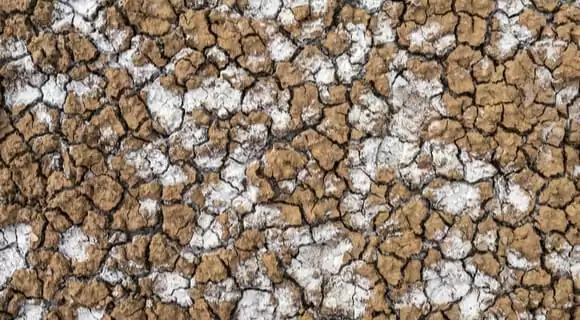
Surface Changes Because Of Salinization
- damp areas and waterlogging;
- ground whitening at early stages and salt crystals at late ones;
- increased water level in furrows;
- bare soils (where plants fail to grow due to salinization);
- deterioration of roads, buildings, etc.;
- white or dark circles around water bodies.
Salinization-Related Indicators In Vegetation
- plant withering;
- crop loss;
- reduction of biodiversity;
- appearance of salt-tolerant plants in the area and their further dominance.
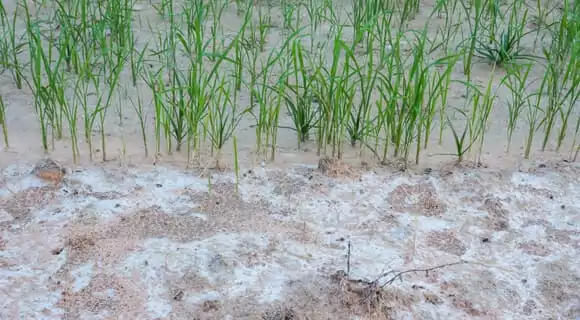
Soil Salinity Measurement
Apart from visual estimation, there are more reliable methods to measure soil salinity, e.g., to assess the earth’s electric conductivity with specific devices. With a rise of salt concentration in the solution, its conductivity rises, too. Other types of soil salinity tests find out the exchangeable sodium percentage or sodium absorption ratio.
Besides laboratory tests, salinization is estimated on farmlands or remotely. Salinity sensors are used for monitoring surface soil salinity in the field. Satellites retrieve data with SWIR and NIR bands for remote sensing analytics of water absorption and its possible correlation with salinity.
Adverse Effects Of Salinization
Soil salinization consequences are far from positive, covering multiple aspects of ecology and human life. It affects crop production and water supply industries, induces the risk of floods and soil erosion, and decreases biodiversity.
Agricultural Production
Water saturation in plants depends on the level of salts in groundwater and the plant itself. Water is absorbed in the process of osmosis and flows from less salt-concentrated areas to more concentrated ones. When the salt concentration is too high, it means that the soil’s osmotic potential is essentially negative. Plants suffer from osmotic stress when they fail to take up water, even when it is present in the soil. Basically, the process is similar to drought stress due to a lack of moisture in the ground. As a result, vegetation dies. Salinization tampers with nitrogen uptake too, which slows plant development and causes a yield loss.
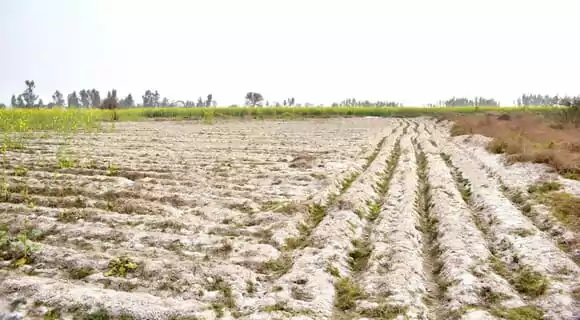
Another soil salinity effect on agriculture is ionic stress due to harmful ions in soil salts, e.g., chloride or sodium. Apart from their toxic impact as such, these positively charged ions impede the acquisition of other positively charged ions vital for crop growth (particularly potassium and calcium). The result is the same as with osmotic stress due to salinization – vegetation dies.
EOSDA Crop Monitoring
Fields analytics based on high-resolution satellite images to track all the changes on-the-spot!
Water Quality
The problem with salinization is that salts not only accumulate in earths but penetrate to initially fresh water bodies as well, leading to their salinization. It deteriorates drinking and irrigation water and adds to further salinization of drylands.
The Colorado River basin is one of the most affected areas in the world. The river salinity grew twice during the last 60 years in Colorado, Arizona, Utah, California, Wyoming, and New Mexico. The impact is multifold:
- contaminates farmlands;
- deprives river species of their natural habitats;
- spoils the taste of drinking water for humans and domestic animals;
- reduces access to fresh water for grazing cattle;
- deteriorates adjusting constructions (concrete, wood, metal, etc.).
Biodiversity
While non-saline soils do not affect crops, strongly saline ones are suitable only for salt-tolerant species and halophytes. Thus, salinization reduces ecosystem varieties and threatens their normal conditions to exist. A reduction of flora diversity inevitably causes a reduction of fauna as well by shortening food chains and areas of habitats. Salinization reduces biodiversity in rivers or fresh-water lakes, shortening aquatic populations solely to salt-tolerant species.
Soil salinization effects refer to crop diversity and, correspondingly, food variety as farmers are forced to produce plants that can survive in salty earths.
Soil Erosion
Soil salinization is a serious problem itself, but it rarely comes alone. Salinity causes continuous wetness of land surface and a lack of cover due to poor plant growing conditions. These make lands highly prone to erosion.
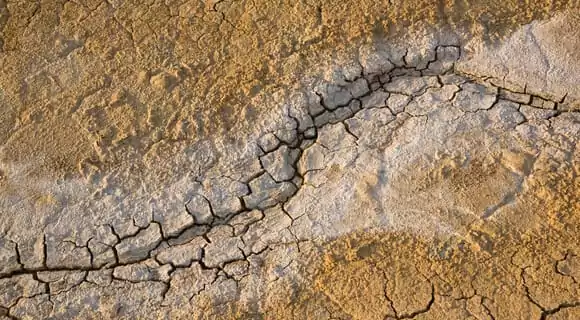
Flood Risk
Water table rise due to salinization reduces the earth’s ability for water infiltration. With heavy rainfalls or river flooding, soils cannot cope with high amounts of water flows. Thus, insufficient absorption results in runoffs and floods. Strong water currents ruin constructions, damage farmlands, increase sedimentation, and contaminate aquatic bodies.
Soil Salinity Control And Prevention
The best way to deal with soil salinization is not to let it happen. In case it did, it is important to eradicate the problem – the sooner, the better, before the consequences get too severe. So, soil salinization solutions deal with prevention and management.
How To Prevent Soil Salinization?
Soil salinization prevention bases on avoiding excessive salt penetration. Even though plants require a certain amount of salts to develop, their needs are small compared to the content in salt-affected soils. Here are some typical methods to prevent soil salinization:
- Optimize irrigation (reduce salty water usage, implement drip irrigation, use desalinated, recycled, rain-harvested water, and don’t overirrigate).
- Add organic matter and manure to keep moisture and reduce irrigation.
- Restrain from deep tillage/heavy machinery not to transfer soil salts to the root zone area, which induces salinization.
- Use cover crops or mulch to protect the ground surface.
As a preventative measure, EOSDA Crop Monitoring allows tracking the vegetation state in the field and identifying areas with sparse vegetation or bare ground surface. Timely scouting of such zones enables farmers to understand and eradicate the root cause, tackling the issue before it gets too severe.
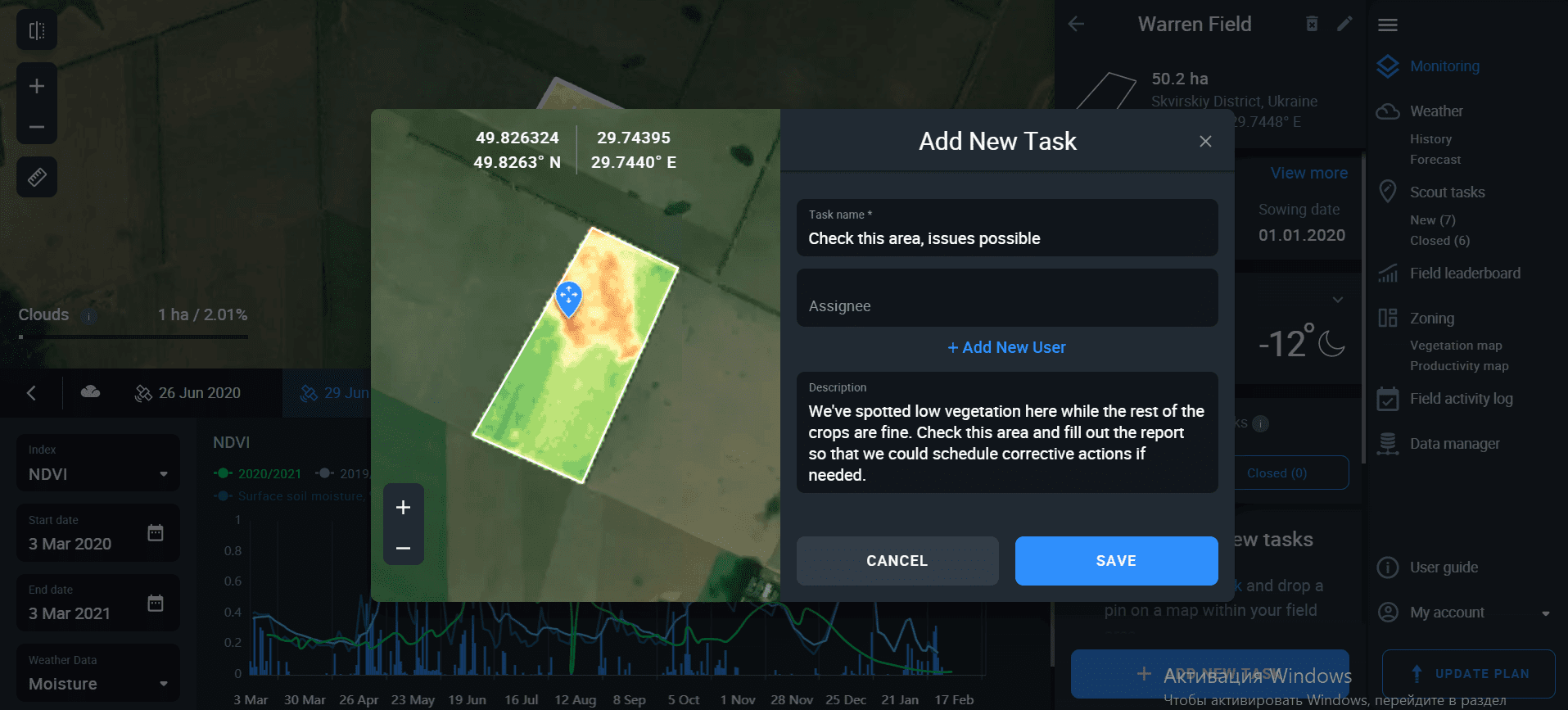
How To Reduce Soil Salinity?
There are several techniques to tackle salinization and improve agricultural productivity:
- Increase drainage for better flushing (to remove salts from the ground surface).
- Plant salt-tolerant crops to manage economic risks and to ensure land cover.
- Remove salt crystals from the surface mechanically.
- Restore the balance via chemical amendments (e.g., gypsum or sulfuric acid).
- Pre-treat seeds with NaCl to promote seed germination .
- Reduce evaporation with mulch or crop residue.
- Grow crops that can absorb moisture properly to avoid prolonged wetness of lands.
- Apply fertilizers rationally, as an overuse of certain chemicals promote salinization.
EOSDA Crop Monitoring may assist the process of reducing soil salinity. Shallow-rooted plants may not reach subsoil moisture, and extra subsoil moisture may induce salinity. EOSDA Crop Monitoring provides reports on surface soil moisture and root-zone moisture, facilitating the choice of crops for planting in the exact areas.
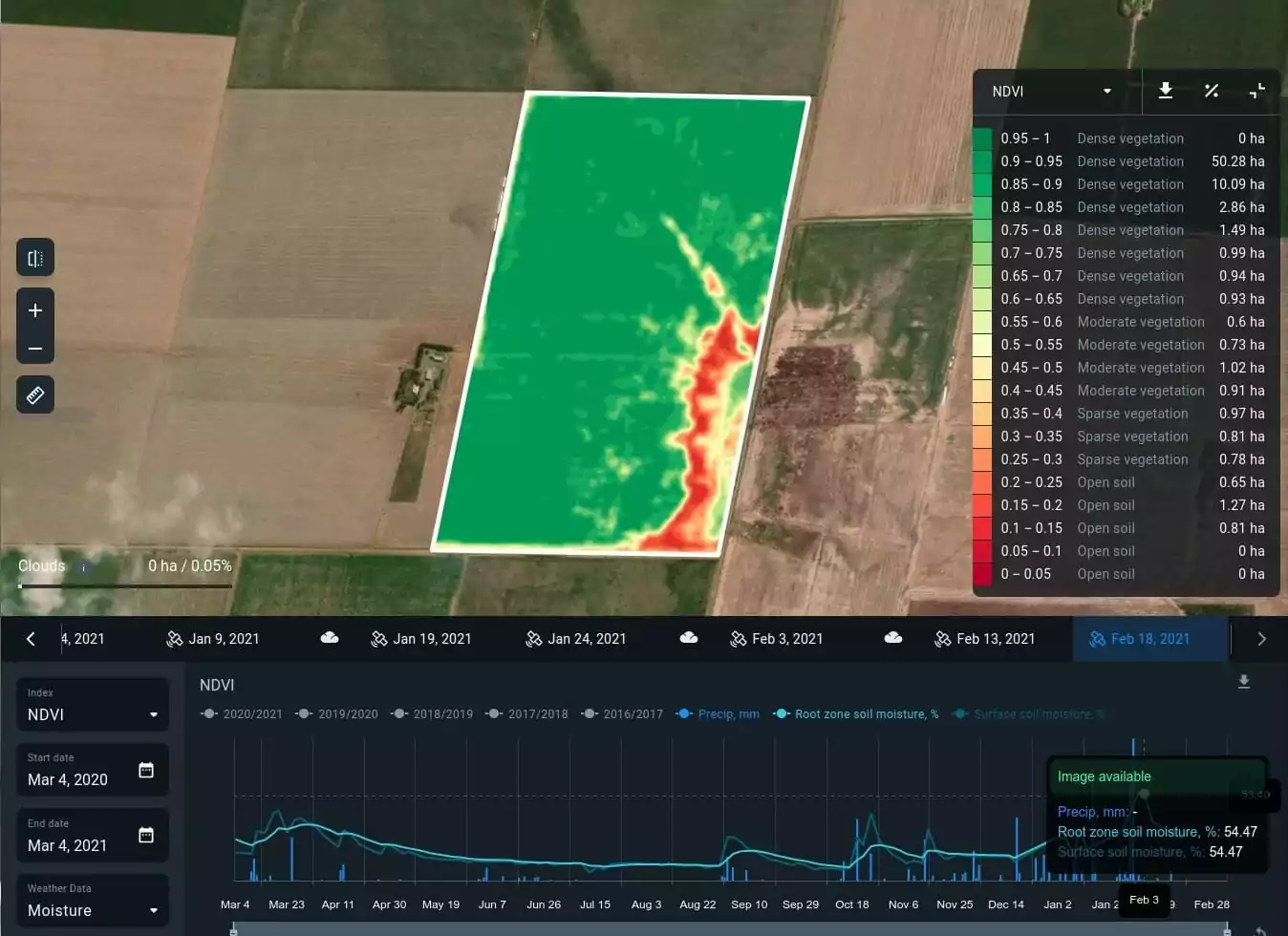
Differentiated fertilization thanks to VRA maps on EOSDA Crop Monitoring mitigates the risks of salinization due to excessive chemical application. It assists in applying chemicals in the amounts a separate field area requires: no more, no less. Variable rate application tool generates maps for different purposes.
Vegetation maps show the current difference in vegetation health dividing the field by zones. Detecting insufficient crop growth, farmers can distribute fertilizer application depending on the area’s need, putting more where vegetation is low and less where vegetation is high. This way, they avoid excessive fertilization and reduce costs.
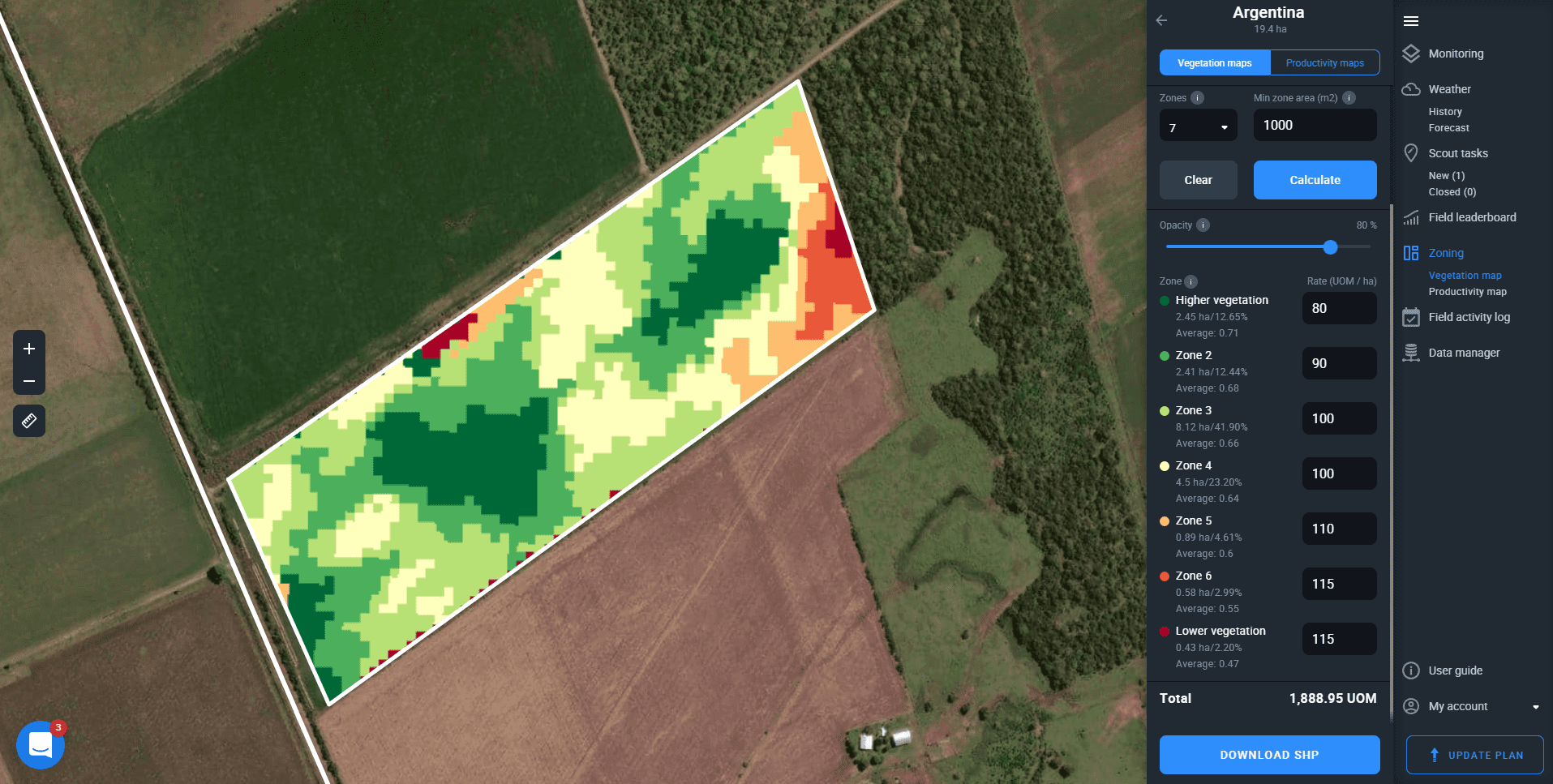
Productivity maps analyze the historical field productivity in the selected period of time and help to make necessary amendments with potassium and phosphorus, taking into account vegetation needs in each particular zone.
EOSDA Crop Monitoring is useful during the plant choice at the sowing stage, fertilizer distribution, and through-season vegetation cover monitoring, thus contributing to soil salinity management in agriculture. EOSDA Crop Monitoring performs big data analytics to assess crop health at different stages of plant growth, keeping a keen eye on the fields and alerting farmers to dangers. Agribusiness with precision farming software gets easier.
About the author:
Vasyl Cherlinka is a Doctor of Biosciences specializing in pedology (soil science), with 30 years of experience in the field. He attended the engineering college in Ukraine and received his degree in agrochemistry, agronomy and soil science in the Chernivtsi National University. Since 2018, Dr. Cherlinka has been advising EOSDA on problems in soil science, agronomy, and agrochemistry.
Recent articles
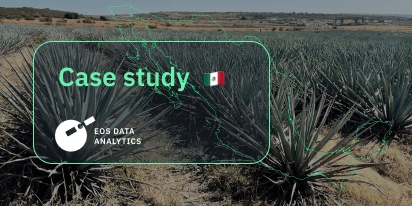
Digital Tools Improve Soil Health And Yields In Mexico
EOSDA and ITTA supported a Guanajuato farm with contour-line planning, monitoring tools, and practical guidance to reduce soil erosion and improve yields in the long run.

Analyze 2025 & Plan Your Best Year Yet: LandViewer Christmas Offer
It’s the most wonderful time of the year! The Christmas holidays are here, and so is your chance to analyze 2025 and plan a prosperous 2026 with more affordable Pro plans in LandViewer.

EOSDA Models Climate Change Impact On Sugarcane Yields
EOSDA modeled future temperature, rainfall, and other climate impacts on Veracruz sugarcane. The results help growers plan long-term adaptation strategies, including timing, varieties, and irrigation.